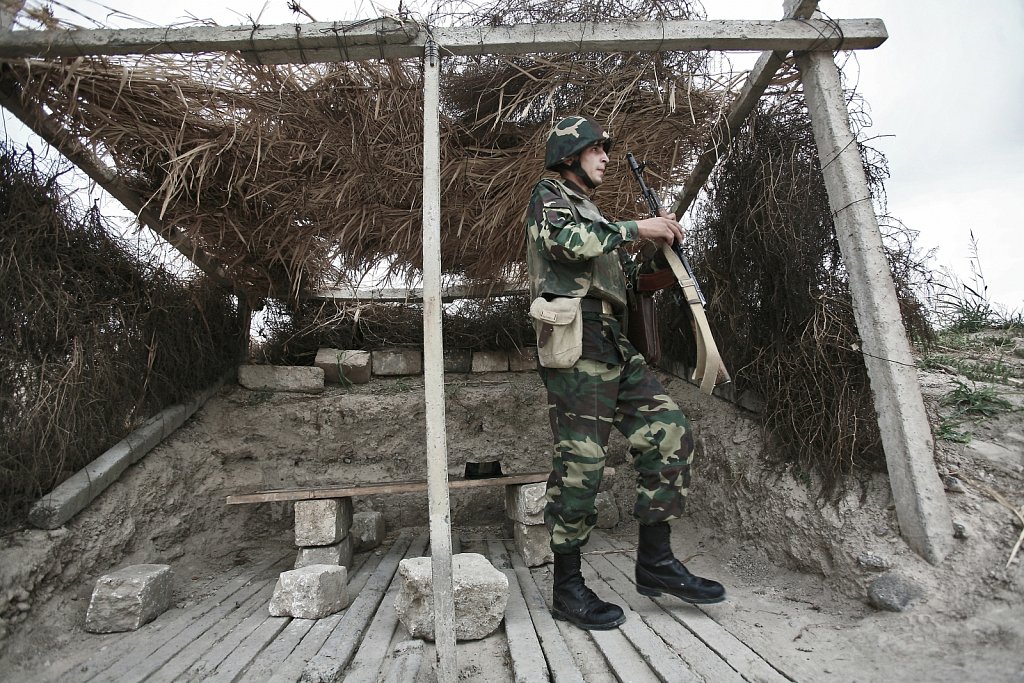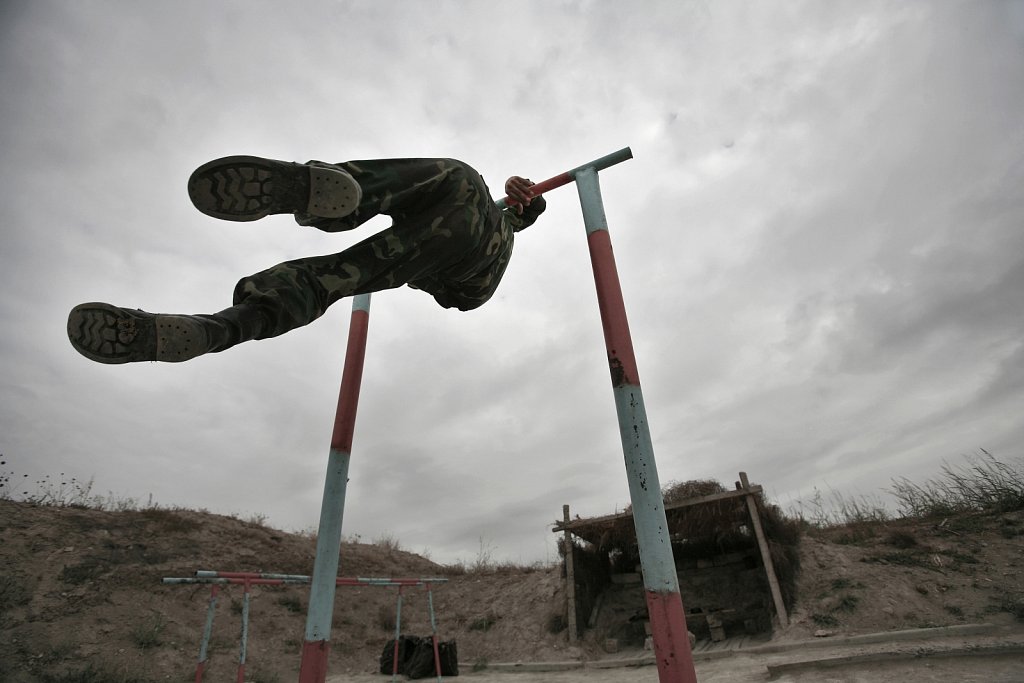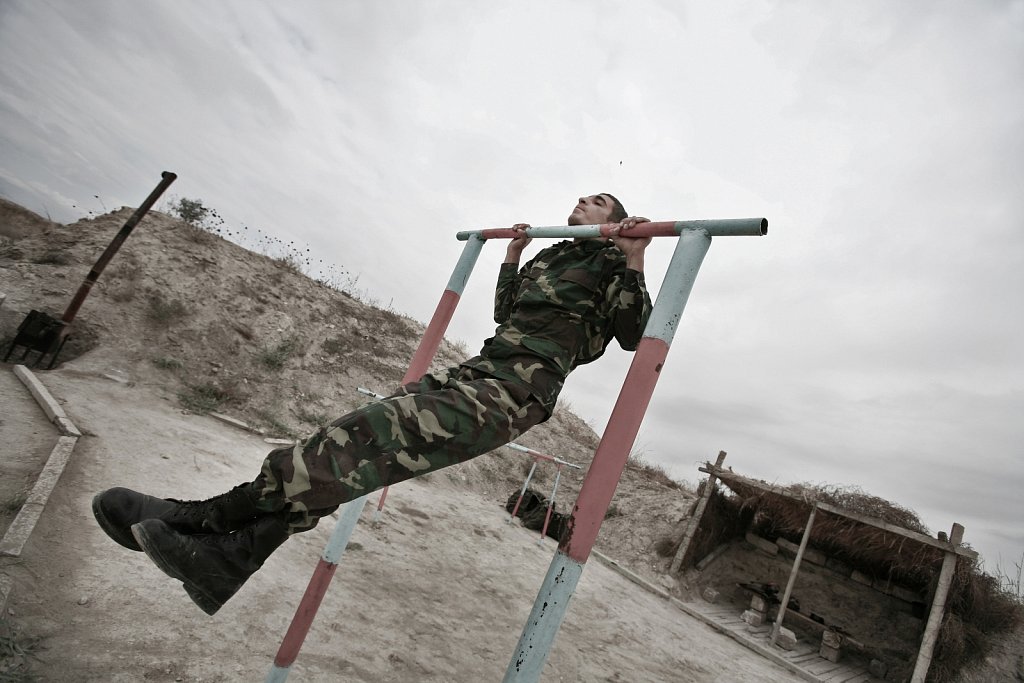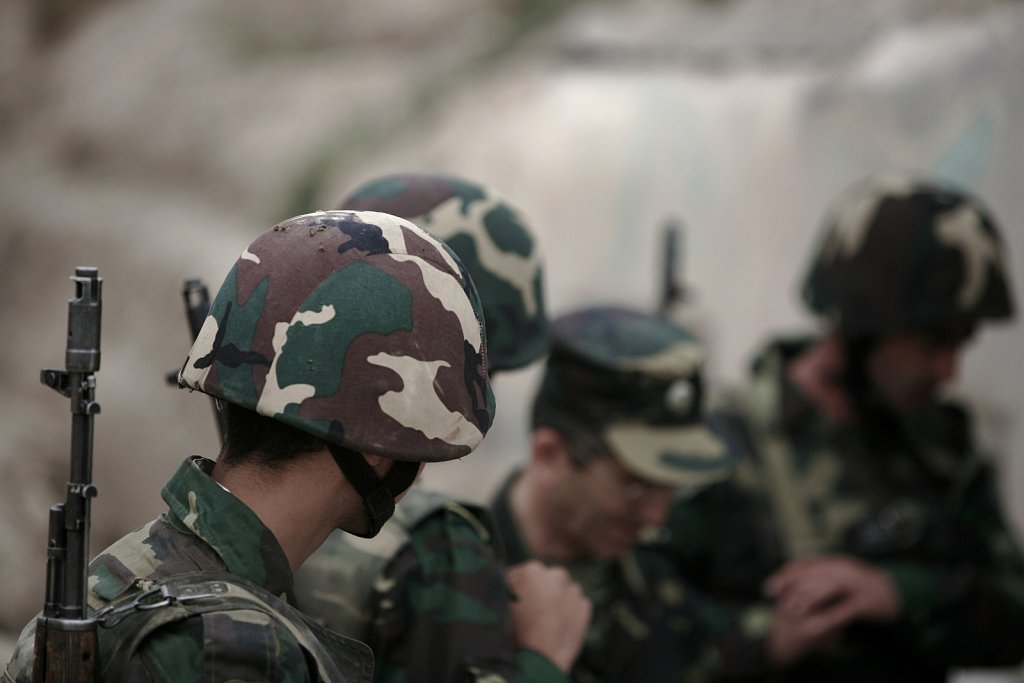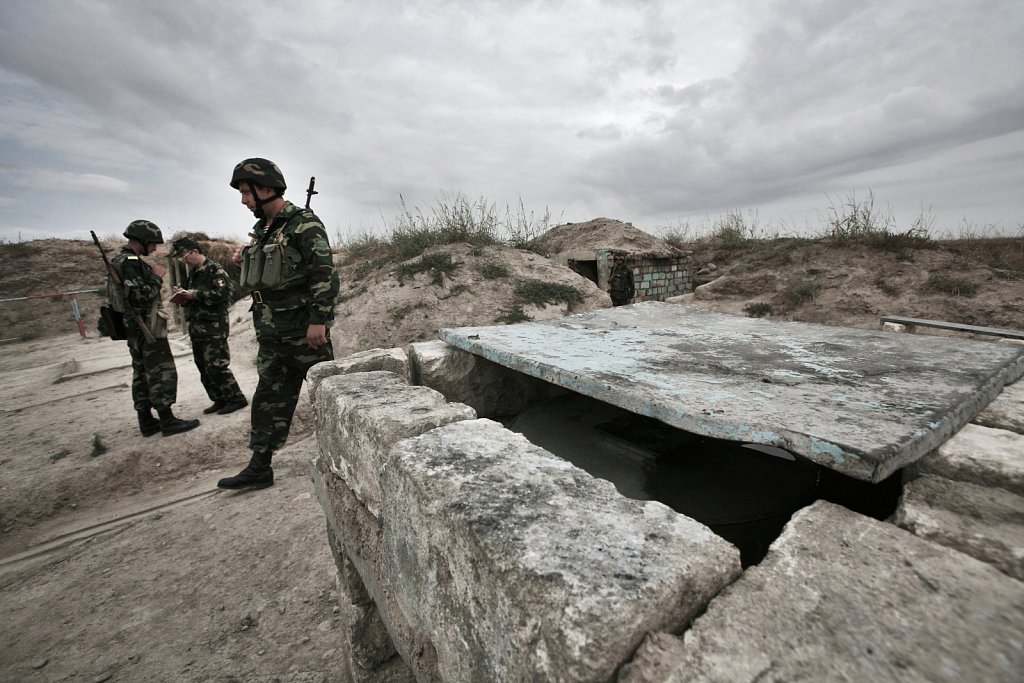
Nagorno-Karabakh
Soldiers patrol the border area with Azerbaijan - 300 m from the Azeri security point - in the Martakert military base situated on the Northeast borderline with Azerbaijan. The Nagorno-Karabakh Republic Defense Army is the formal defense force of the Nagorno-Karabakh Republic and was founded on May 9, 1992. The army is currently composed of around 20,000 officers and soldiers and its primary role is the protection of the NKR from foreign and domestic threats. Violations of the cease fire along the frontier are frequent and often result in the deaths of several soldiers and civilians each year. One of the most dangerous spots on the borderline with Azerbaijan is Martakert. In Nagorno-Karabakh and Armenia the military service is compulsory for two years for the citizens at age of 18-27. Many of the Armenian soldiers are deployed in military units close to the border with Azerbaijan. Armenia officially declared itself as a guarantee of security of Nagorno Karabakh, but it doesn’t officially recognize the independence of Nagorno Karabakh. This makes military service a sensitive issue for both Karabakh's ethnic and Armenian population. Martakert, Nagorno-Karabakh, 20 September 2008.
Nagorno-Karabakh
Soldier Kevork (age 23) is doing his personal military training in the Martakert military base situated on the Northeast borderline with Azerbaijan. The Nagorno-Karabakh Republic Defense Army is the formal defense force of the Nagorno-Karabakh Republic and was founded on May 9, 1992. The army is currently composed of around 20,000 officers and soldiers and its primary role is the protection of the NKR from foreign and domestic threats. Violations of the cease fire along the frontier are frequent and often result in the deaths of several soldiers and civilians each year. One of the most dangerous spots on the borderline with Azerbaijan is Martakert. In Nagorno-Karabakh and Armenia the military service is compulsory for two years for the citizens at age of 18-27. Many of the Armenian soldiers are deployed in military units close to the border with Azerbaijan. Armenia officially declared itself as a guarantee of security of Nagorno Karabakh, but it doesn’t officially recognize the independence of Nagorno Karabakh. This makes military service a sensitive issue for both Karabakh's ethnic and Armenian population. Martakert, Nagorno-Karabakh, 20 September 2008.
Nagorno-Karabakh
Soldier Kevork (age 23) is doing his personal military training in the Martakert military base situated on the Northeast borderline with Azerbaijan. The Nagorno-Karabakh Republic Defense Army is the formal defense force of the Nagorno-Karabakh Republic and was founded on May 9, 1992. The army is currently composed of around 20,000 officers and soldiers and its primary role is the protection of the NKR from foreign and domestic threats. Violations of the cease fire along the frontier are frequent and often result in the deaths of several soldiers and civilians each year. One of the most dangerous spots on the borderline with Azerbaijan is Martakert. In Nagorno-Karabakh and Armenia the military service is compulsory for two years for the citizens at age of 18-27. Many of the Armenian soldiers are deployed in military units close to the border with Azerbaijan. Armenia officially declared itself as a guarantee of security of Nagorno Karabakh, but it doesn’t officially recognize the independence of Nagorno Karabakh. This makes military service a sensitive issue for both Karabakh's ethnic and Armenian population. Martakert, Nagorno-Karabakh, 20 September 2008.
Nagorno-Karabakh
Soldier Kevork (age 23) is doing his personal military training in the Martakert military base situated on the Northeast borderline with Azerbaijan. The Nagorno-Karabakh Republic Defense Army is the formal defense force of the Nagorno-Karabakh Republic and was founded on May 9, 1992. The army is currently composed of around 20,000 officers and soldiers and its primary role is the protection of the NKR from foreign and domestic threats. Violations of the cease fire along the frontier are frequent and often result in the deaths of several soldiers and civilians each year. One of the most dangerous spots on the borderline with Azerbaijan is Martakert. In Nagorno-Karabakh and Armenia the military service is compulsory for two years for the citizens at age of 18-27. Many of the Armenian soldiers are deployed in military units close to the border with Azerbaijan. Armenia officially declared itself as a guarantee of security of Nagorno Karabakh, but it doesn’t officially recognize the independence of Nagorno Karabakh. This makes military service a sensitive issue for both Karabakh's ethnic and Armenian population. Martakert, Nagorno-Karabakh, 20 September 2008.
Nagorno-Karabakh
A group of soldiers of the Artsakh Defense Forces are seen in the Martakert military base situated on the Northeast borderline with Azerbaijan. The Nagorno-Karabakh Republic Defense Army is the formal defense force of the Nagorno-Karabakh Republic and was founded on May 9, 1992. The army is currently composed of around 20,000 officers and soldiers and its primary role is the protection of the NKR from foreign and domestic threats. Violations of the cease fire along the frontier are frequent and often result in the deaths of several soldiers and civilians each year. One of the most dangerous spots on the borderline with Azerbaijan is Martakert. In Nagorno-Karabakh and Armenia the military service is compulsory for two years for the citizens at age of 18-27. Many of the Armenian soldiers are deployed in military units close to the border with Azerbaijan. Armenia officially declared itself as a guarantee of security of Nagorno Karabakh, but it doesn’t officially recognize the independence of Nagorno Karabakh. This makes military service a sensitive issue for both Karabakh's ethnic and Armenian population. Martakert, Nagorno-Karabakh, 20 September 2008.
Nagorno-Karabakh
An obsidian carved ledger with a picture of an Armenian war hero dressed in his military uniform is seen on a gravestone in the War Memorial cemetery in Stepanakert, the capital of Nagorno-Karabakh Republic. With a population of 140.000, the majority being Armenians, Nagorno Karabakh Republic aims to achieve political and economical stability. The high unemployment rate, low salaries and the lack of opportunities for the youngsters make the unrecognized republic to be a hard place to live. Stepanakert, Nagorno-Karabakh, 20 September 2008.
Nagorno-Karabakh
Laundries are hung up for drying between apartment blocks in a residential district in Stepanakert. With a population of 140.000, the majority being Armenians, Nagorno Karabakh Republic aims to achieve political and economical stability. The high unemployment rate, low salaries and the lack of opportunities for the youngsters make the unrecognized republic to be a hard place to live. Stepanakert, Nagorno-Karabakh, 20 September 2008.
Nagorno-Karabakh
Children play with a ball in a residential district in the capital Stepanakert. With a population of 140.000, the majority being Armenians, Nagorno Karabakh Republic aims to achieve political and economical stability. The high unemployment rate, low salaries and the lack of opportunities for the youngsters make the unrecognized republic to be a hard place to live. Stepanakert, Nagorno-Karabakh, 20 September 2008.
Nagorno-Karabakh
A new married couple enters the restaurant to celebrate, downton Stepanakert. With a population of 140.000, the majority being Armenians, Nagorno Karabakh Republic aims to achieve political and economical stability. One of the Gouvernament's program targets to stimulate marriage and birth, every new formed family receives cash payments for each baby born, with the aim of repopulating the region after the devastating 1991-1994 war. The high unemployment rate, low salaries and the lack of opportunities for the youngsters make the unrecognized republic to be a hard place to live. Stepanakert, Nagorno-Karabakh, 20 September 2008.
Nagorno-Karabakh
A schoolgirl walks down the stairs in the Khomitas Musical School from Stepanakert. Besides learning the classical instruments, the pupils also learn how to play to traditional instruments like duduk, kanun, zurna, oud or saz. Stepanakert, Nagorno-Karabakh, 20 September 2008.
